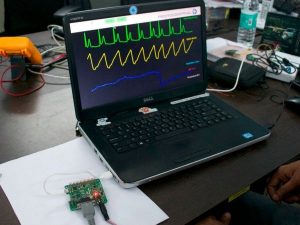We initially made HealthyPi as HAT add-on board for Raspberry Pi. Now you can run the application on any desktop PC with a USB port.
Project
We introduced the HealthyPi as a HAT add-on for the Raspberry Pi, turning it into a full-featured, medical-grade open patient monitor. However, we realized later that people also wanted to use the board standalone with a Windows/Linux/Mac PC. We already had an on-board USB port from the SAMD21 on the board.
If you do not already have a HealthyPi board, you can buy one here. The latest version is now available for shipping.
What is HealthyPi now?
HealthyPi is now a standalone ECG, respiration and pulse oximetry/SpO2 monitor with a USB-CDC interface. HealthyPi has its own GUI written using processing with Java, and natively compiles across the Windows, Linux and MacOS platform.
HealthyPi is NOT a certified medical device and is not intended for diagnostic medical applications.
The HealthyPi firmware now runs on Arduino. The Arduino Zero bootloader is pre-loaded on all HealthyPi boards shipping after February 20, 2017. This means that you don’t need a JTAG debugger or Atmel Studio if you would like to tweak the code running on the SAMD21 microcontroller.
Setting up HealthyPi for use with a PC
- Make sure you have the latest version of Java installed for your platform. If in doubt, go to https://java.com/en/download/ to download and install Java.
- Install the latest version of Arduino from the Arduino website. This is required for the Arduino Zero USB driver as well as reprogramming the HealthyPi if you wish to do so later.
- Plug in the HealthyPi PCB to your computer through the on-board micro-USB port and a micro-USB cable.
- On Linux and MacOS, the drivers should automatically be installed and it shows up as a serial port. On Windows, upon plugging-in the cable, the device should get recognized and drivers will be installed. You can go to the Windows Device Manager and look under Ports (COM & LPT) to find out the COM port number for the installed device.
Read more: Using HealthyPi with a PC for ECG, Respiration & SpO2

